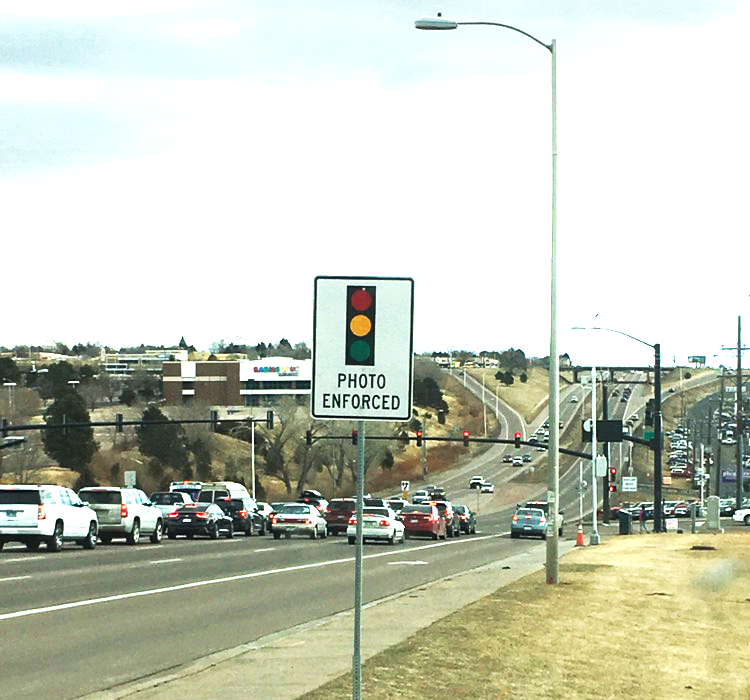Colorado Exhibits
| C1 | Colorado Photo-Enforcement LawPaying a red-light camera citation in Colorado is voluntary. Section 42-4-110.5(2)(a)(II), the city has 90 days to serve the defendant. If you are not served within 90 days, the penalty notice is void. Whether you pay or not, Colorado does not assess insurance points, does not immobilize the driver's vehicle, does not enter any judgments, and does not keep record of the infraction. Credit-reporting agencies do not accept photo-enforcement citations as debts; therefore, unpaid citations never appear on your credit report. So while you may receive a nasty-gram from a debt-collection agency, there is nothing the agency can do to collect. Section 42-4-110.5(2)(a)(II)(b) "Notwithstanding any other provision of the statutes to the contrary, the state, a county, a city and county, or a municipality may not report to the department any conviction or entry of judgment against a defendant for violation of a municipal traffic regulation or a traffic violation under state law if the violation was detected through the use of an automated vehicle identification system." Section 42-4-110.5(2)(f)(3) "The department has no authority to assess any points against a license under section 42-2-127 upon entry of a conviction or judgment for a violation of a municipal traffic regulation or a traffic violation under state law if the violation was detected through the use of an automated vehicle identification system. The department may not keep any record of such violation in the official records maintained by the department under section 42-2-121." Section 42-4-110(6)(b) "A state agency or a political subdivision of the state shall not adopt or enforce a policy, rule, or ordinance that sets standards for an automated driving system that are different from the standards set for a human driver." Yet, red-light camera systems punish drivers using the precision of a computer as the standard. Watch the video clip in exhibit CP3. A human cannot tell that the vehicle's front bumper crossed over the stop line before the light turned yet. This is literally outside the brain-visual perception ability of a human being. Also watch video 5 on the home page. The driver cannot even tell he ran a red light. |
Nov 29, 2022 | |||
| C2 | Professions and Occupations ActColorado Revised Statute 12-120-202(2) and (6)(a) requires the "practice of engineering" to conform to the "application of the mathematical and physical sciences." Section 12-120-204 requires red-light camera installation plans to be sealed and signed by a Colorado licensed professional engineer who is in responsible charge of and directly responsible for the engineering work. |
Nov 29, 2022 | |||
| C3 | Professional Engineers' Rules and Ethics |
Jan 15, 2019 | |||
| C4 | Colorado Counties Building Permit RequirementsColorado Revised Statute CRS 30-28-205 enables counties to grant building permits for buildings and/or structures. If the plans for these structures require engineering work, then the plans must be signed and sealed (aka, certified) by a Colorado licensed professional engineer. Red-light camera installation plans are engineering works. See exhibit CD2. |
Nov 29, 2022 | |||
| C5 | Colorado MUTCD Supplement
|
May 6, 2022 |
Denver Exhibits
| CD1 | Red-Light Camera Installation Plans, DenverThis report contains the Denver's red-light camera installation plans as well as other engineering items (like yellow timings for select intersections) pertinent to the red-light camera project. The installation plans have never been certified as required by law. See exhibit C2. |
Jan 15, 2019 | |
| CD2 | Colorado Ruling Against RedFlex for Producing Uncertified Engineering PlansIn 2019, the Colorado Board of Engineers issued a cease and desist order against people who drafted red-light camera installation plans for RedFlex for Denver. Such plans are engineering works and so must be certified by a Colorado licensed professional engineer. These plans were not certified. The people who drafted the plans are not engineers. See requirement in exhibit C2. |
Nov 7, 2019 | |
| CD3 | Owner-Not-Driver No-Fink-on-Driver Denver LawPaying a red-light camera ticket in Denver is voluntary. When you get a red-light camera citation, the citation omits a legal option. City of Denver ordinance Sec. 54-833 allows you to send an affidavit saying you were not driving at the time and location on the citation. You do not have to fink on the driver. |
Jan 15, 2019 |
Pueblo Exhibits
| CP1 | Pueblo's Vehicle Owner Liability LawSection 15-1-15(c) allows an owner to declare himself not liable when he did not give permission to the person driving his car at the time of the infraction. (In hindsight, no owner allows a person to drive his car knowing that the person is going to run red lights.) The Pueblo ordinance also does not force the owner to fink on the driver. Refer to Exhibit C1--the State's enabling statute. Because Pueblo's red-light cameras take a picture of the driver, it is not so easy to say, "It wasn't me." But it could be a family member. It could be your wife. You do not have the fink on your wife. Section 15-1-15(f)(3) explicitly exempts the city from adhering to the rules of evidence. Whether this violates the 14th Amendment is a question for an attorney. If due process is egregiously violated, then Pueblo crosses the line. Perhaps exhibit CP3 crosses the line. In the photos and video of exhibit CP3, half the evidence shows it's nighttime while the other half shows it's daylight. Section 15-1-15(f)(6): oversteps the State enabling statute. The enabling statute forbids a municipality to transfer the citation from the Court system to a different department, not even to the Police Department.
|
Jan 23, 2023 | |
| CP2 | Pueblo Red-Light Camera NoticeA Pueblo notice has a picture of the driver's face. We redacted the picture. |
Dec 1, 2022 | |
| CP3 |
|
Pueblo Photo 1
|
Dec 1, 2022 |
| CP4 | Pueblo Requires Red-Light Camera Installation Plans to be CertifiedIn Colorado, like other States, municipalities have building permit laws separate from counties. Colorado municipalities use the International Building Code (IBC) as their base building code. In Section 4-1-11(1), Pueblo amends the IBC in order to require the seal and signature of a Colorado licensed professional engineer for engineering plans. Also, a red-light camera installation plan requires a seal and signature from a licensed surveyor: these plans contain precision maps used to locate the red-light camera structures. |
Nov 29, 2022 | |
| CP5 | Pueblo will not Disclose Red-Light Camera Installation PlansPueblo's city attorney will not disclose the red-light camera installation plans to the requester. It is not because the attorney does not want to, but because the city does not have the plans. Verra Mobility did not give the plans to the city because the plans are probably unlawful, and that the city did not press Verra Mobility to obtain the plans. The plans were probably not signed and sealed by a licensed professional engineer. The plans are illegal. Because the City of Denver possessed its red-light camera installation plans, Denver disclosed them to the public. (There is nothing to hide on the plans, unless it is the omission of a seal and signature of a licensed professional engineer.) The Colorado Board condemned those plans as unsigned unsealed plans. The plans are illegal. See exhibit CD2. Verra Mobility keeps Honolulu, Hawaii's plans a secret too. Same is true for NYC. In these cases, we do not know whether it is Verra Mobility withholding the information, or the city, or both. |
Nov 29, 2022 | |
| CP6 | Colorado Board of Engineers will not Obtain Red-Light Camera Installation Plans
|
Nov 29, 2022 |


